A Paipo Interview with Robert Moynier
September 22, 2011 - Cambria, California, U.S.A
E-mail interview by Bob Green
A Paipo Interview with Malcolm Campbell
October 24, 2011 - Oxnard, California, U.S.A
E-mail interview by Robert Moynier
Robert Moynier was interviewed a year ago
and at that time was riding stand-up
and at times prone, on bonzer boards ranging in length from 7'8" to 9'.
In his collection he had a short paipo from the 1980s made by Gordon
Theisz. He decided to revisit the design of this board with the
assistance of Malcolm Campbell. The result: two bonzer paipos. Robert
describes his surfing experiences and thoughts on these new boards
which, while modern designs, also have strong links to the past, going
back to
Wally Froiseth. Malcolm provides insights into his board design experience and Moynier's boards.
|
The surfer's story - Robert Moynier
1. Originally you were a bit wary about riding and
damaging your
classic board but I believe you had been surfing it exclusively before
you got some new boards. What happened?
You're right that I
really don't want to ding
up that board! It's such a great piece of functional surfing
archeology and although it's 30 years old, it's still in "as new'
condition.
As you know, it is based on the Wally Froiseth paipo design from the
mid-fifties and was built by Gordon Theisz for Candy Calhoun in 1980.
There is a real connection there. I believe Gordon and the Calhouns
may have been riding these specific kind of boards for about 20 years
at that point.
In any case, we received the board pretty soon after it was made, never
really rode it, and so remarkably, it's stayed in its pristine
condition ever since then. That potentially could have changed about a
year or more ago when I randomly swam out with it at a glassy little
beach break, and somehow immediately lucked into a freakish "Crystal
Voyager" type tube that essentially blew me away and left me both
shaking my head and totally stoked. The damn board felt really speedy
and sensitive in a unique way, and using the handle to manoeuver was
definitely a real trip. It felt less like a surfboard and more like a
very fast go-cart, or maybe a bob-sled!
Similarity of boards that served as a baseline for Robert Moynier's Bonzer paipo.
|
| Wally Froiseth's Board, ca. 1956. |
Candy Calhoun's Board board built
by Theisz, 1980. It is 3'10" |
 |

|
Board lengths are not to scale.
Photos courtesy of Wally Froiseth and Robert Moynier. More photographs
may be found throughout the
MyPaipoBoard.org website.
|
Whatever it was, that was my first wave, and from then on I became
progressively more intrigued with trying to understand and experience
what the board was all about. There is a lot of information in that
little vehicle, and you really just can't sit there and look at it to
figure out what it's trying to tell you. You have to take it out and
ride it, experience what it was designed for.
So that's what I did for about 6 to 7 months. Took me about a month to get
serious and break down and buy some swim fins, and from then on it was
just a constant discovery adventure. It's all I rode, and I went out in
everything that came my way locally, as well as a couple trips to some
point breaks when they were breaking. Clearly, I had become "paipo
possessed," which was the last thing I expected to happen at this stage
of the game. But wow! This stuff is fun, and really, really
interesting. So I just kept going with it. And, by the way, apart from
a few little deck "pukas" from elbow pressure, I never dinged it up at
all!
2. How has it been
rediscovering paipo boarding?
I think
"rediscovering paipo" might be a bit
of a generous description in my case. I started surfing in 1959, and
like a lot of people began on skim boards, paipos, foamies, mats, and
body surfing. After about 3 years of that it was on to "real"
surfboards, and the prone experience, while never forgotten, and always
respected, was nonetheless random and definitely an exception to my day-to-day surfing happenings.
Things began to change about 3 years ago as mentioned before and the
actual paipo discovery is only about a year's worth, so it's a
relatively brand new phenomena for me.
Having said all that.. how has the "discovery" been? Well, pretty mind
boggling for a start. Kind of like taking a trip to Mars or stepping
into a parallel universe that exists just slightly hidden from most
others' point of view and reference.
First of all, you are basically swimming most of the time, immersed in
the ocean, not on top of it, so there is a whole other set of skills
required in terms of the paddling out, catching the waves, knowing where
you are and where the takeoff zone is, as well as the fact you are
primarily looking around from a sea level perspective. It's
simultaneously a very intuitive, but physical experience. And of course,
you do feel a little bit more a part of the aquatic food chain, but
that's not something I dwell on too much.
Having fun on
the Theisz paipo
|
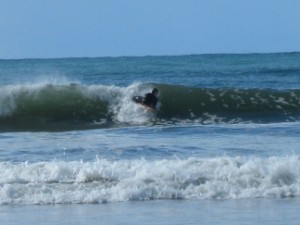
|
|

|
Photos
courtesy of Robert Moynier.
Another aspect of the paipo experience so far is the fact that, for the
most part, I really don't know what's going to happen during any given
surf session. While I can gauge conditions fairly easily enough, and
mentally suggest to myself the best lines to take as I look at the
waves, my conditioned frame of reference for decades has been based on
so called "normal/real" surfing, not paipos, so it's really a
discovery, wave-by-wave, as to what the board is doing, what I'm doing,
what works, what doesn't, along with the occasional out of the blue "I
don't know what the hell just happened, but I like it, let's try that
again!"
That entire feeling of a beginner's mind, learning how to surf again, and
leaving the water in a state of wonder is as big a draw as anything
else, maybe the most attractive thing about the entire experience.
Right now there is very little that is predictable about my surf
sessions, and that runs the gamut from how I look at waves, where to
place myself in the line-up, dealing with other surfers, paddling, and
of course, riding the waves themselves. All things considered it is
really a fun trip. Even riding the soup can turn into a blast and like
I say I generally leave the water mumbling something like, "damn that
was interesting... can't wait to do it again!"
3. What are the design
features of the new boards and how do they ride?
The new boards are
pretty intentional, pretty
specific, and came about after that 6 months of riding the
Froiseth/Theisz board in all kinds of waves. At that point I felt I
could appreciate at least some of the boards potential and
characteristics and I wanted to see if there was a next step with these
things.
What it came down to was really fundamental and general to most surfers
regardless of what they ride: how to take this board and increase its
speed and in this case, not just it's planing speed, but it's acquired
speed as a result of turning velocity, turning radius, and it's ability
to get into the "race track" ramp, or curl line where the board
really excels.
As a planing surface, from template, to foil, to rails, the
Froiseth/Theisz board is really a quite sophisticated and functionally
sound high performance design, but very soon after getting into it, my
thought was "this template... it's tailor made for a Bonzer bottom and
fin system. Keep everything else the same, add some length to increase
turning circumference, and this could be really interesting." That was
the deal.
From Theisz to
Campbell
|
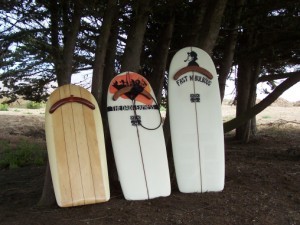
|
|

|
Photos
courtesy of Robert Moynier.
There was no doubt in my mind that the fundamental hydrodynamic
principles embodied in the Bonzer bottom/fin systems would translate
seamlessly and efficiently onto this type of board, and to test that
out was pretty simple: build one, or in this instance, build two, and
see what happens.
It helped just a bit that my closest friend (along with his brother,
Duncan) is Malcolm Campbell, co-creator of the Bonzer and considered by
many knowledgeable people to be one of the very best shapers going
today. Malcolm had been listening about my paipo obsession (with some
amusement I think) since it started, and we had surfed a couple times
with me on the paipo, so he had a pretty good idea what I had in mind.
Malcolm
Campbell and his son, Jacob, with the 4'6" paipo. Jacob was the "creator extraordinaire" of the artwork on the
boards.
Malcolm with the 5' paipo.
|

|
|

|
Photos
courtesy of Robert Moynier.
With some input from others, we settled on two boards to put together:
a 4'6" with the traditional Bonzer 3-fin setup, and the other
a 5-foot with a contemporary Bonzer 5-fin setup. Each board followed
the Froiseth/Theisz design as closely as possible, from template, to
foil, thickness, rails, and rocker. Everything duplicated with the
exception of length (the Theisz board is 3'10"). And, of course, the most
important difference: the Bonzer double-concave and fin system.
Robert happy
with his new boards
|

|
|

|
Photos
courtesy of Robert Moynier.
The
5-foot board came first. By comparison to the Theisz paipo, this
board has close to 25 percent more surface area and volume. As an
example of
what that means, if the Theisz board was 7-foot, then the new Bonzer
with
the same template etc., would come in at around 8'8'. That's a big
jump, and in fact, that is a whole lot of planing surface and foam
flying around for a paipo. This was the primary reason to go with the
5-fin system: it tends to have a bit more snap off the turns, and it
also provided the opportunity with the bigger board to go to a 4-fin
setup depending on conditions and see where that might lead. [See the
board specifications in this Note.]
Five- and three-fin bottom contours.
|


|
|
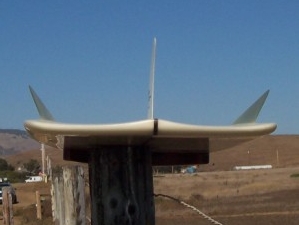
|
Click on images for a larger version. Photos
courtesy of Robert Moynier.
From the time we measured and calibrated out the Theisz paipo, to the
finished Bonzer board, around 4 months had passed. Malcolm is
singularly meticulous in his craft, and as the shape revealed itself he
wanted to review the original design to make sure we were headed in the
right direction before he completed it. Add to that the making of the
mahogany handles, glassing, the "amazingly smooth and intricate"
artwork, and you end up with quite a little collaborative project.
These things take time.
When I picked it up, I was amazed, a little stunned, and totally
stoked! It is a unique example of paipo surfcraft to say the least.
It's both one of kind and derivative, something on the level of "future
history" or, as someone else aptly described it "a space time overlap."
Beyond that, and most importantly, I knew right after my first handful
of waves that this thing really works! It was clearly very fast, gets
up to planing speed right away, pivots on a dime but projects down the
line when required, held into the section "tighter than a tin tear
drop" and felt remarkably smooth and powerful coming out of a turn. In
other words, it seemed to do exactly what we hoped it would, and then
some.
On that basis, the 4'6" design was a go, and went more quickly. This is the
mid-range board between the 3'10' and the 5-foot boards, and utilizes the
Bonzer 3-fin keel runners setup. I wanted foremost to maximize the
turning velocity and radius as much as possible on this one, and I
think that's exactly what happened. The 4'6" is nimble, achieves
planing speed remarkably quickly, is uber fast, and absolutely loves
the barrel. Like the 5-foot board, it can hold a very tight trim in the
top third of the wave for what seems to be an extended time.
Robert
on a glassy left
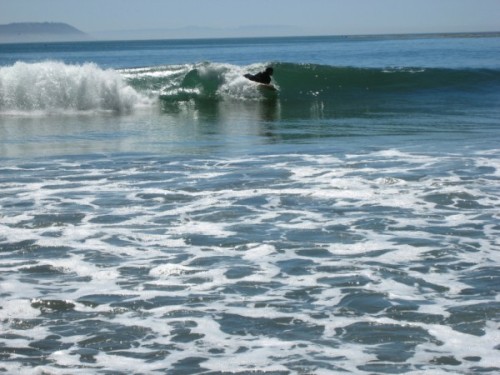
Photo
courtesy of Robert Moynier.
Of the three boards so far, it may well be the most "go to" vehicle on
a day-to-day basis, but only more water time and experience will tell.
As a rough automotive analogy as to how each of these boards ride, you
could think of the 5-foot board as a full throttle Ferrari, the 4'6" as
a fuel-injected Bugatti, and the 3'10' as some kind of hopped-up high
performance go-cart. With each board you will more than likely make
any given decent wave--the question is, "How do you want to ride the
wave during that process and, what is the board doing, what is it
telling you as you ride the wave?" That's the fun part and makes each
go out an adventure.
4. What is the function of the
handgrip at the
front? Is it just to hang on to during wipeouts, etc., or does it
assist turning? If the later, how? I'm generally interested in the
technique you use to turn and gain speed on these boards.
The handles are
integral to these types of
boards and have little to do with wipeouts, although I guess they're
useful in some of those situations. I'm riding the boards with no wax
on the deck. A glossed, relatively slippery surface that allows your
body to both pivot around the board, following it after a turn and then
pull up on it (with the handles) when adjusting into trim and also
allowing the board to become a kind of a lever that you apply pressure
to through body english to do a whole range of things... turn,stall,
control or release drift speed, or whatever is appropriate.
Robert
demonstrating use of the handles

|
|

|
Photo
courtesy Robert Moynier.
In some ways it's similar to using a handplane while bodysurfing, but
there's more to it than that.
When pulling up into a section, you might be doing a number of things.
You can have your inside hand on the handle, outside hand anywhere on
the outside rail, applying pressure as needed, then when in the curl or
speed line both hands squarely on the handle for the drive. In some
instances, both hands on the handle allow a kind of "slalom" or
circular, type of surfing, or depending on the wave, you can grip both
hands on the handle for a "gouging" type of bottom turn, and after the
pressure is off, release again, with the body following the turn,
briefly off the board, attached only by the handle.
Late takeoffs might be both hands on the handle, early takeoffs you
can fade in with two hands driving, pivot the board with one hand and,
again follow the board after it gets to planing speed and adjust from
here. Absolutely great for controlled drifts, side slips (stalls), and
kind of mind altering for what I call "riding side saddle with the
lord." That's where you basically push the board at a certain angle
away from your body while in a section, just attached to the handle and
follow it for as long as it makes sense, then pull yourself back on the
board and away you go.
I've had some great kinds of foam ball experiences with that one and you
don't seem to lose any speed which seems odd given your body is just
following the board. Lately I've been riding the 5-foot board without the
center fin, and have found that the lateral drift (in the power part of
the wave) seems to generate its own kind of unusual speed
characteristic. When you release the torque, it has the same effect as
a very long bottom turn with a definite increase in speed coming out of
it; maybe more than if you were just holding a straight line trim. In
this instance, the body is generally (not always) squared up on the
board. Couldn't be doing that, or at least I couldn't, without the
handle to help control velocity and speed, and this is another
interesting thing to explore with these boards.
Bottom line at this point, is that the combination of slippery deck and
handle, while maybe a bit counter intuitive, is a totally functional
approach to surfing these craft, and opens up some unique and
unexpected wave riding experiences. And that's good enough, for now.
5. What's Next?
More surfing, that's
for sure.
I'm definitely looking forward to this winter for some point break
surfing, can't wait to stretch out the Bonzers and see where they go. I
would love to see some other paipo riders, and their boards, in the
flesh. See what they are on about and have them ride my boards and hear
what they have to say.
What's really going on is an exploration of the capacity and potential
of these boards. It's unknown to me where this may lead, but there is a
lot of information to be uncovered, and really, how great is it that
that can only be done by surfing them? No doubt other boards will come,
but at present I'm really stoked and grateful to have the
"Froiseth-Campbell Bros. Bonzer" paipo to surf with. They represent a
unique link
from the past, direct to the future, that allows a taste of both during
each present surf session. Back to that "space time overlap," or
"future history" theme.
I guess all I can say is "surf on," and thank you Wally, Gordon, Candy,
and Malcolm and Jacob Campbell!
Wally Froiseth
and his paipo, ca. 1956.
|

|
|

|
Photos
courtesy of Wally Froiseth.
The surfcraft designer and innovator story - Malcolm Campbell
The
first bonzer boards were made by Malcolm and Duncan Campbell in
Oxnard, California in December 1970. The design has been refined
over time but the core components remain. Malcolm provides insights
into his board design experience after being asked to revisit a classic
paipo design.
1. The approach to shaping these paipos was essentially
to
duplicate the Froiseth/Theisz board while incorporating the Bonzer
bottom and fin system. What were your impressions of the Theisz board
in terms of what it represents, it's apparent performance potential,
and how that would mesh with the Bonzer system?
To me the Theisz-design paipo is a example of, and
represents a long, storied history of an approach to wave riding.
Things don't hang around, and remain in use for decades, unless the
essential design principles are strong. This fundamental shape, with
small variations, has been consistently used for wave riding vehicles
longer than any other. paipos, belly boards, body boards have utilized
the basic concept. Obviously large differences exist within this
extended family. The consequential differences arise in the materials
they are constructed with, and the fin and bottom contours they
incorporate.
When Robert approached me with the idea of a Bonzer paipo I had no
doubts. For 40 years we have 'Bonzerized' kneeboards, the entire range
of surfboards, tow boards, sailboards, and even one bellyboard [see Note 1].
In every case we achieved enhanced performance capabilities. The key
here would be integrating the tried and true aspects of the paipo with
what we have learned working with the Bonzer bottom and fin concept.
Malcolm
Campbell at the 2011 San Diego Sacred Craft meet with new additions to
the broad paipo family. [See Note 2
for more information on board specifications.]
|
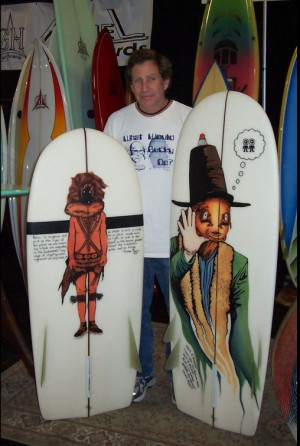
|
|
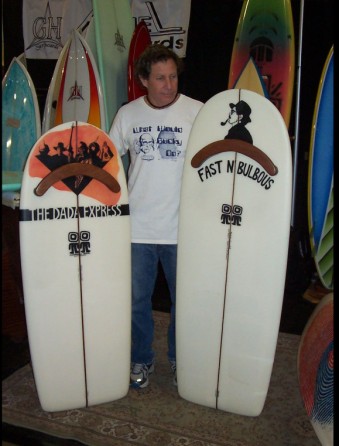
|
Photos
courtesy of Robert Moynier.
2. Did you feel the Bonzer
system would, or could, improve the surf capacity of the basic Theisz
template and foil? How so?
As far as whether I
felt that the Bonzer
system would "improve" the basic paipo concept, I don't mean to be
wishy washy, but things can get a bit subjective when entering this
territory. Different people want different things out of their
equipment. Duncan and I have always approached surfboard design with
the idea of maximizing speed, maneuverability and control as a holistic
unit. We look toward getting the maximum performance with the least
amount of energy input. In this respect, the Bonzer-paipo combo, would
be a slam dunk.
The Bonzer concaves combined, with the wide base, low-profile side-fins,
efficiently utilize the energy created by the water passing under the
board, especially during turns. The long base of the side fins,
combined with the degree of the cant, also provide great "edge
control" that enable the board to maintain speed and hold its line
when driving around long, crumbling sections, and tube riding.
The 5-foot paipo on
the stands.
|
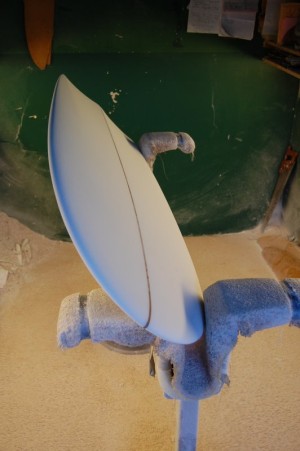
|
|
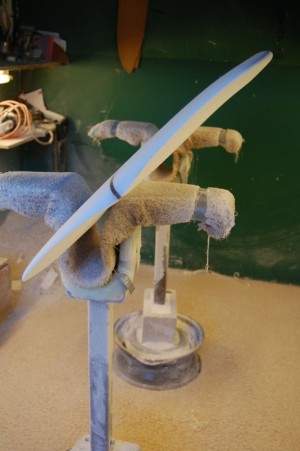
|
Photos
courtesy of Robert Moynier.
3. You shaped the 5-foot paipo
first and during the process had some concerns. What were those concerns and do you
feel they were resolved?
My basic concern with
the 5-footer was
the amount of planing area in relation to being able to maintain
enough control and maneuverability at high speed. I knew the board
would, as my Dad used to say, "Go like Jack the bear," but the question
was, "Would you be able to make the fine adjustments necessary to
effectively navigate the wave in tight situations?"
The Theisz board was 3'10'', so doing a 5-footer was a big leap.
Since our aim was to stick with the Theisz template there were was only
a couple of adjustments I felt I could do to address this potential
problem. One was to make the tail slightly narrower and the other was
to make sure that the tail was not too thick. Hopefully this would
allow a bit more control at high speed. By your description of how the
board rides it seems that we were relatively successful. This being
said it seems that the 5-footer occupies a niche different to the
shorter versions.
The 3'10" Theisz and the 5-foot Bonzer
|
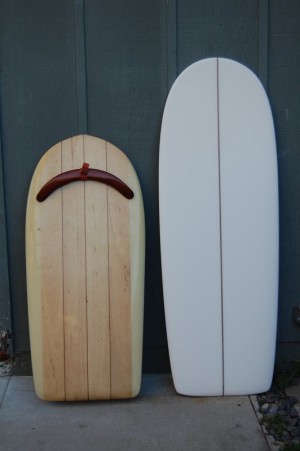
|
|
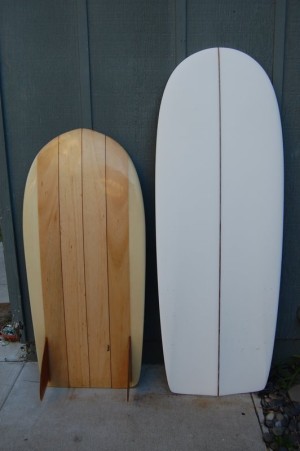
|
Photos
courtesy of Robert Moynier.
4. How about the 4'6" board...
how did that
feel to you while shaping it after the first one, and what about the
choice of the different fin setup's (5-fin vs. 3-fin) for each
board... what were your thoughts on that?
The
template of the
4'6'' came together much
easier. It seemed much more natural, and conducive to the paipo medium.
After working through the mental space of shaping the 5-footer, the
4'6'' was a relative breeze. As far as the choice between the 3- and
5-fin systems, I think that you made a good decision to go with the
five on the 5-footer and the three on the 4'6''. There is not a
quantum difference between the two, but basically the 5-fin setup
allows a bit more maneuverability in the hollow or critical spaces of a
wave. This is more evident when moving at higher speeds. Since the five
foot board has a naturally higher planing speed, it made sense to try
to bring it under control with the 5-fin setup.
5. The choice of blanks was
important. What did you use, why, and how long were they? What role did
rocker play in deciding what length of blank was required?
I used the same style
blank for both boards.
It was a US Blank, 6'8'' RP with reduced rocker and "classic" weight
foam. I went with the heavier foam to keep the elements of weight,
volume, area and flotation somewhat in line with the general paipo
concept.
6. If you were to shape a new
paipo from
scratch, with no reference to any other design, what do you think that
board would look like?
That's a tough
question. Honestly until
making these boards for you I have not put much thought into the paipo
realm. I have always been a "form follows function" kind of guy, so for
me to venture out of the basic paipo form, I would have to put in some
quality time riding waves in this manner to know what different
direction, if any, I would take. Our design work originates out of
trying to solve problems and overcoming inefficiencies. This requires
experience within the particular medium that you are working. In terms
of paipo surfing, I just don't have it.
7. Your thoughts on paipo in
general... where do you think it sits in the overall context of surfing
and surfcraft performance, past, present and future?
As a kid, bodysurfing
and bellyboarding is
what got me hooked on the sensation of riding waves. I think that the
fundamental nature of paipo surfing, the closeness to the wave face,
ensures that it will always be a part of surfing.
8. My guess is there may be
20 to 30 people
on a global level who would love to have you shape a paipo for them. If
they were nice, kind, interesting and patient humans... would you
consider their request?
I am always open for
shaping adventures,
although I must admit that I have been severely dragging my feet, and
not entered the world of SUPs.
I would be up for doing some custom paipos. My approach would be to
adapt the Bonzer system to what the particular person is riding. This
way people can more accurately assess whether or not the Bonzer
provides performance attributes that fit with their approach to wave
riding. In many ways surfing is an individually creative experience,
and we aim to maximize and integrate the use of the Bonzer within the
context of that paradigm. [See Note 3 for information on where to find a fuller discussion on the Bonzer paradigm.]
The paradigm
maximized
|
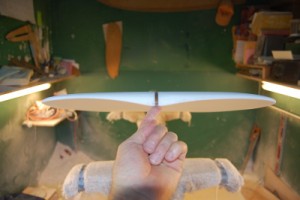
|
|
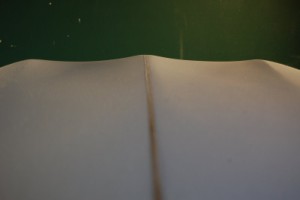
|
Photos
courtesy of Robert Moynier.
Note 1: This
bellyboard was about 4-foot long, had a 3-fin Bonzer setup, and
featured an inverted arc tail. It was made for a friend who was at that
time partially paralyzed on his left
side.
He was able to get out in the shorebreak shallows and and launch into
the soup with it.The inverted arc was for body comfort while riding
along.
Note 2: Selected board specifications are shown in the table below.
|
4'6" 3-fin Bonzer
|
5'0" 5-fin Bonzer
|
Widest point
|
21-1/2 inches
|
21-1/2 inches
|
Nose
|
20-1/4 |
20-1/4 |
Tail
|
20-1/8 |
20 |
Tailblock (pod)
|
16-3/4 |
17 |
Thickness
|
1-1/2 to 1-11/16th maximum |
1-1/2 to 1-11/16th maximum
|
Center fin (fin box)
|
6-inch True Ames Bonzer center fin
|
6-inch True Ames Bonzer center fin |
Bonzer keel runner side fins
(glassed on)
|
10-inch length at base x 2-1/2 inch high trailing edge |
Front fins: 5-1/2 inch base x 2 inch trailing edge
Aft fins: 6 inch base x 2-1/2 inch trailing edge
|
Glassing (both boards)
|
2 layers of 6 oz. cloth, top and bottom, plus elbow
patches running vertically below the handle
|
Handle (both boards)
|
Mahogany, resined on deck after
gloss coat |
Nose and tail measurements are twelve inches from either end and dimensions are
within 1/8th inch or so.
Note 3:
For more information on the Bonzer design paradigm, see the Campbell
Bros Surfboards website and the following articles:
-
Barilotti, Steve. (2004, Spring). Belief System: The long, strange saga
of the Bonzer. The Surfers Journal, 13(2), 94-109.
-
Buck, Simon. (2008, October). Opening The Door On The Quiet Revolution. Surfer’s Path, (68), 94-101.
- Campbell, Malcolm. (2011, November). Forty Bonzer Years. Drift Surfing. Accessed on January 26, 2012. Read the article.
Feel free to send me suggestions, comments and additional
information to: The
Paipo Interviews
|
|

























